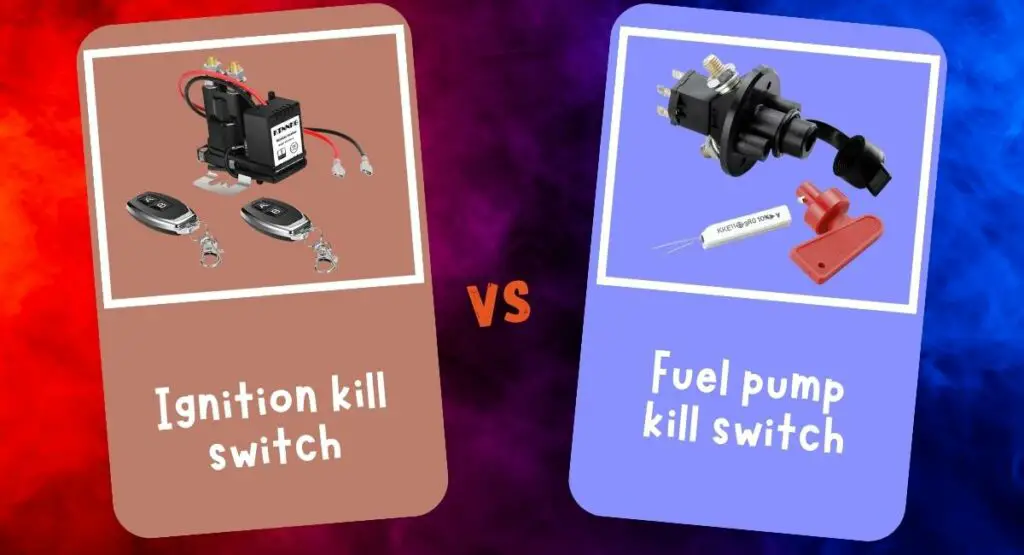Vehicle theft is a concerning issue that plagues car owners worldwide. In 2022, the National Insurance Crime Bureau (NICB) reported that more than one million vehicles were stolen. Protecting your vehicle from theft is preserving your investment and ensuring your peace of mind.
Installing a kill switch is one of the most effective methods to enhance vehicle security. Kill switches are specialized security devices that disrupt the normal functioning of a vehicle’s ignition or fuel system, making it extremely difficult for thieves to start and drive away with your car.
Read on to explore the differences between two popular types of kill switches: the ignition kill switch vs. fuel pump kill switch. Understanding their mechanisms and effectiveness lets you decide which option best suits your vehicle theft prevention needs.
Overview of Ignition Kill Switch
An ignition kill switch is designed to interrupt the flow of electricity to the vehicle’s ignition system, thereby preventing the engine from starting. By cutting off the power supply to the ignition system, the switch renders the car immobile and inoperable for unauthorized individuals.
Installing an ignition kill switch involves wiring it into the vehicle’s electrical system and positioning it in a discreet location that is challenging for potential thieves to locate.
The ignition kill switch is a straightforward solution that completely turns off the ignition system. Thieves would require knowledge of the specific wiring configuration and the switch’s location to bypass it successfully.
Turning off the ignition system through an ignition kill switch can make the vehicle appear dead, effectively discouraging theft attempts altogether.
A Step-by-Step Guide to Installing an Ignition Kill Switch
If you’re considering installing an ignition kill switch, here is a step-by-step overview of the installation process:
Locate the appropriate wires.
Identify the wires connecting the battery to the ignition or starter circuit. These are the wires you will be working with during the installation process. Refer to your vehicle’s wiring diagram or consult a professional if needed.
Disconnect the battery
Safety should always be a top priority. Before starting any electrical work, disconnect the vehicle’s battery to prevent any accidental electrical shocks or damage.
Connect the kill switch.
Install the kill switch in line with the ignition or starter circuit and the battery. You can do this by cutting the appropriate wires and connecting them to the terminals on the kill switch. Make sure to follow the manufacturer’s instructions and ensure a secure connection.
Choose a suitable location.
Decide where to position the kill switch. It is wise to place it in an inconspicuous location and hard for potential thieves to locate. It could be under the dashboard, inside the center console, or any other discreet area that suits your vehicle’s layout.
Reconnect the battery
Once you install the kill switch securely, reconnect the vehicle’s battery. Double-check all connections and ensure they are tight and secure.
Test the switch
Before considering the installation complete, test the kill switch to ensure it functions correctly. Turn the ignition key to the “On” position and activate the kill switch. The engine should not start when the switch is activated. Repeat the process a few times to verify consistent results.
Overview of Fuel Pump Kill Switch
On the other hand, a fuel pump kill switch disrupts the fuel supply to the engine. The switch prevents fuel from reaching the engine cylinders by cutting off power to the fuel pump. Without fuel, the engine cannot start or run.
Like an ignition kill switch, a fuel pump kill switch is installed by connecting it to the vehicle’s electrical system and positioning it inconspicuously.
While a fuel pump kill switch can prevent the vehicle from starting, it primarily targets the fuel supply rather than the ignition system. However, it is essential to note that some modern vehicles have sophisticated anti-theft mechanisms that can detect the interruption in the fuel supply and immobilize the car, making a fuel pump kill switch less effective in those cases.
Installing a Fuel Pump Kill Switch
If you’re considering installing a fuel pump kill switch, here are step-by-step instructions to guide you through the process:
Locate the fuel pump relay.
Before starting the installation, locate the fuel pump relay in your vehicle. This relay is responsible for controlling the fuel pump’s operation. Consult your vehicle’s manual or wiring diagram to identify the relay’s location.
Disconnect the battery
Prioritize safety by disconnecting the vehicle’s battery. This precautionary measure eliminates the risk of electrical shocks or damage during installation.
Cut the circuit
Identify the circuit that powers the fuel pump. In some vehicles, cutting the wire that supplies power to the fuel pump may be necessary. Carefully sever this wire to prepare it for installing the kill switch.
Connect the kill switch.
Install the fuel pump kill switch in line with the fuel pump or fuel pump relay and the cut circuit. Follow the manufacturer’s instructions and make sure to create secure connections. Ensuring that the kill switch interrupts the power flow to the fuel pump effectively is crucial.
Reconnect the battery
Once the kill switch is properly connected, reestablish the connection to the vehicle’s battery. Double-check all connections to ensure they are secure and tight.
Test the switch
To confirm the correct functionality of the fuel pump kill switch, turn the ignition key to the “On” position. Activate the kill switch, and the engine should not start or receive fuel. Repeat the process a few times to ensure consistent results.

Comparison of Ignition Kill Switch vs. Fuel Pump Kill Switch
The ignition kill switch vs. fuel pump kill switch serves the same purpose of preventing unauthorized individuals from starting and operating your vehicle. But, they differ in their mechanisms and effectiveness in thwarting theft attempts.
With its direct approach of turning off the ignition system, the ignition kill switch is generally more challenging for thieves to bypass. It requires more expertise and knowledge of the vehicle’s wiring configuration. By cutting off power to the ignition system, the switch effectively immobilizes the car, making it a less attractive target for theft.
However, it is essential to note that a fuel pump kill switch can be relatively more straightforward for determined thieves to bypass. Although it does interrupt the fuel supply, skilled criminals may still find ways to hotwire the vehicle or employ alternative methods to circumvent the switch.
Additionally, the effectiveness of a fuel pump kill switch can diminish in vehicles equipped with advanced anti-theft technologies that can detect the interruption in the fuel supply and trigger immobilization.
Factors to Consider in Choosing the Right Kill Switch
When deciding between ignition or fuel kill switches, you should consider the following factors:
Vehicle Makes and Model
Different vehicles have varying electrical systems and security features. Consulting with professionals familiar with your vehicle’s specifications can help determine the most suitable kill switch option.
Skill Level of Potential Thieves
It is essential to assess the specific expertise of thieves in your area. If vehicle theft is prevalent and thieves are skilled in bypassing particular types of kill switches, opting for a combination of multiple security measures may be wise.
Existing Vehicle Security Features
Some vehicles have advanced fuel pump cutoff switches for theft prevention. These mechanisms include immobilizers and sophisticated alarm systems. Assessing the effectiveness of these features can help determine whether an additional kill switch is necessary and which type would complement the existing security measures.
Important Read: NGK vs Denso Ignition Coils: Unleashing the Sparks
Personal Preferences and Budget
Consider your comfort level and budget when choosing a vehicle kill switch. While both types offer security enhancements, the decision ultimately depends on your needs and financial constraints.
Additional Security Measures
It is advisable to combine the installation of a kill switch with other security measures to maximize vehicle security. This multi-layered approach helps create a more robust deterrent against theft. Consider the following additional security measures:
- Combination of ignition and fuel pump kill switches: Installing both an ignition kill switch and a fuel pump kill switch provides an additional layer of protection. Even if you bypass one switch, the other acts as a backup to immobilize the vehicle.
- Integration with alarm systems and immobilizers: Combining a kill switch with an alarm system and an immobilizer can create a comprehensive security package. The alarm system alerts you and others to unauthorized access attempts, while the immobilizer prevents the engine from starting even if a thief bypasses the vehicle kill switch.
- Steering wheel locks and tracking devices: Supplementing kill switches with physical deterrents like steering wheel locks adds an extra barrier against theft. Tracking devices, such as GPS trackers, can aid in recovering stolen vehicles by providing real-time location information.
Conclusion
When it comes to vehicle theft prevention, installing ignition or fuel kill switches is an effective security measure. Both ignition and fuel pump kill switches serve the purpose of immobilizing the vehicle and deterring theft attempts. However, the choice between the two depends on factors such as the vehicle make and model, the skill level of potential thieves, and the existing security features. Combining a kill switch with other security measures provides a comprehensive approach to safeguarding your vehicle. Remember to consult professionals for guidance and proper installation to maximize the effectiveness of the chosen kill switch.

